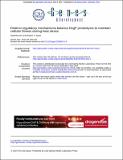Distinct regulatory mechanisms balance DegP proteolysis to maintain cellular fitness during heat stress
Author(s)
Kim, Seokhee; Sauer, Robert T
DownloadKim-2014-Distinct regulatory mechanisms.pdf (1.469Mb)
PUBLISHER_CC
Publisher with Creative Commons License
Creative Commons Attribution
Terms of use
Metadata
Show full item recordAbstract
Intracellular proteases combat proteotoxic stress by degrading damaged proteins, but their activity must be carefully controlled to maintain cellular fitness. The activity of Escherichia coli DegP, a highly conserved periplasmic protease, is regulated by substrate-dependent allosteric transformations between inactive and active trimer conformations and by the formation of polyhedral cages that confine the active sites within a proteolytic chamber. Here, we investigate how these distinct control mechanisms contribute to bacterial fitness under heat stress. We found that mutations that increase or decrease the equilibrium population of active DegP trimers reduce high-temperature fitness, that a mutation that blocks cage formation causes a mild fitness decrease, and that combining mutations that stabilize active DegP and block cage formation generates a lethal rogue protease. This lethality is suppressed by an extragenic mutation that prevents covalent attachment of an abundant outer-membrane lipoprotein to peptidoglycan and makes this protein an inhibitor of the rogue protease. Lethality is also suppressed by intragenic mutations that stabilize inactive DegP trimers. In combination, our results suggest that allosteric control of active and inactive conformations is the primary mechanism that regulates DegP proteolysis and fitness, with cage formation providing an additional layer of cellular protection against excessive protease activity.
Date issued
2014-04Department
Massachusetts Institute of Technology. Department of BiologyJournal
Genes & Development
Publisher
Cold Spring Harbor Laboratory Press
Citation
Kim, S., and R. T. Sauer. “Distinct Regulatory Mechanisms Balance DegP Proteolysis to Maintain Cellular Fitness During Heat Stress.” Genes & Development 28, no. 8 (April 15, 2014): 902–911.
Version: Final published version
ISSN
0890-9369